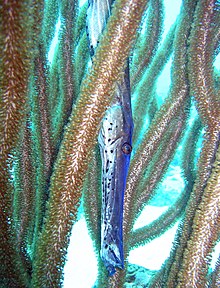Syngnathiformes
| Syngnathiformes Temporal range:
| |
|---|---|

| |
Aulostomidae ), head in natural pose
| |
| Scientific classification | |
| Domain: | Eukaryota |
| Kingdom: | Animalia |
| Phylum: | Chordata |
| Class: | Actinopterygii |
| (unranked): | Acanthomorpha |
| Superorder: | Acanthopterygii |
| Clade: | Percomorpha |
| Order: | Syngnathiformes |
| Type species | |
| Families | |
|
See text | |
The Syngnathiformes
These fishes have elongated, narrow, bodies surrounded by a series of bony rings, and small, tubular mouths. The shape of their mouth—in at least
The name Syngnathiformes means "conjoined-jaws". It is derived from Ancient Greek syn (συν, "together") + gnathos (γνάθος, "jaw"). The ending for fish orders "-formes" is derived from Latin and indicates "of similar form".
Fossil record

The earliest known syngnathiform is Gasteroramphosus from the late Cretaceous (either Santonian or Campanian) of Italy, which is similar in form to Marcroramphosus but which has some characters which are suggestive of a relation to Gasterosteoidei.[4] However, most recent studies have reaffirmed it being a syngnathiform.[1][5] The second oldest syngnathiform is the syngnathoid Eekaulostomus from the early Paleocene (Danian) of Mexico.[1] Many fossil syngnathiform families are known from the Paleogene.[6]
Systematics and taxonomy
In some models, these fishes are placed as the
In addition, the Pegasidae (dragonfishes and sea moths) are variously placed with the pipefish or the stickleback lineage. While the placement in Syngnathiformes seems to be correct for the latter, the former is possibly an actinopterygian order of its own.[9] Following the convention of the major fish classification organizations (Fish Base, ITIS, Encyclopedia of Life), the Indostomidae are currently placed in the Gasterosteiformes.
The order as set out in the 5th Edition of Fishes of the World is classified as follows:[11]
- Order Syngnathiformes
- Suborder Syngnathoidei
- Superfamily Pegasoidea
- Family Pegasidae (seamoths)
- Superfamily Syngnathoidea
- Family Solenostomidae(ghost pipefishes)
- Family Syngnathidae (pipefishes and seahorses)
- Subfamily pipefishes)
- Subfamily Hippocampinae (seahorses and pygmy pipehorses)
- Subfamily
- Family
- Superfamily
- Suborder Aulostomoidei
- Superfamily Aulostomoidea
- Family Aulostomidae (trumpetfishes)
- Family Fistularidae (cornetfishes)
- Family
- Superfamily Centriscoidea
- Family Macroramphosidae (snipefishes)
- Family Centriscidae (shrimpfishes)
- Family Dactylopteridae (flying gurnards)
- Superfamily Aulostomoidea
- Suborder
Other authorities are of the view that without the inclusion of other taxa within Syngnathiformes then the order is
- Order Syngnathiformes
- "long snouted clade"
- Suborder Syngnathoidei
- Family Solenostomidae(ghost pipefishes)
- Family Syngnathidae (pipefishes and seahorses)
- Family Aulostomidae (trumpetfishes)
- Family Fistularidae (cornetfishes)
- Family Centriscidae (shrimpfishes and snipefishes)
- Family
- Suborder Syngnathoidei
- "Benthic clade"
- Suborder Callionymoidei
- Family Callionymidae(dragonets)
- Family Draconettidae (slope dragonets)
- Family
- Suborder Mulloidei
- Family Mullidae(goatfishes)
- Family
- Suborder Dactylopteroidei
- Family Dactylopteridae (flying gurnards)
- Family Pegasidae (seamoths)
- Suborder Callionymoidei
- "long snouted clade"
In their study Longo et al (2017) found that there were short distances between the groupings on the Syngnathiform phylogenetic tree and this supported a hypothesis that there had been a rapid but ancient radiation in the basal Syngnathiformes.[13]
Fossil families
The following fossil families are known:[6]
- Family †Aulorhamphidae
- Family †Paraeoliscidae
- Suborder Syngnathoidei
- Family †Eekaulostomidae
- Superfamily Aulostomoidea
- Family †Fistularioididae
- Family †Parasynarcualidae
- Family †Urosphenidae
- Superfamily Syngnathoidea
- Family †Protosyngnathidae
- Superfamily Centriscoidea
- Family †Gerpegezhidae
- Family †
- Suborder Dactylopteroidei
- Superfamily Pegasoidea
- Family †Rhamphosidae
- Superfamily
References
- ^ PMID 37251781.
- ^ FishBase (2005): Order Summary for Syngnathiformes. Version of 2005-FEB-15. Retrieved 19 Aug 2008.
- ^ Langley, Liz (26 November 2013). "Why Does the Seahorse Have Its Odd Head? Mystery Solved – News Watch". Newswatch.nationalgeographic.com. Archived from the original on November 27, 2013.
- ISBN 978-1119220817.
- ISSN 1374-8505.
- ^ ISSN 1477-2019.
- ^ E.G. Helfman et al. (1997), ITIS (2004), Nelson (2006)
- ^ E.g. McAllister (1968)
- ^ PMID 17709262.)
{{cite journal}}: CS1 maint: multiple names: authors list (link - Copeia 1978(3): 517–529. JPEG abstract and first page text
- ^ Nelson, JS; Grande, TC & Wilson, MVH (2016). "Classification of fishes from Fishes of the World 5th Edition" (PDF). Archived from the original (PDF) on 13 March 2020. Retrieved 10 May 2018.
- PMID 28683774.
- ^ S2CID 13929577. Abstract.
- Integrated Taxonomic Information System (ITIS) (2004): Syngnathoidei (TSN 166438). Retrieved 2006-APR-08
- McAllister D.E. (1968). "Evolution of branchiostegals and classification of teleostome fishes". Bulletin of the National Museum of Canada, Ottawa. 221: 1–239.
- Nelson, Joseph S. (2006): ISBN 0-471-25031-7
External links
- Skaphandrus.com Syngnathiformes Archived 2013-02-16 at archive.today
